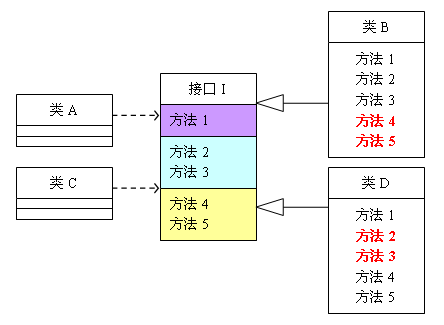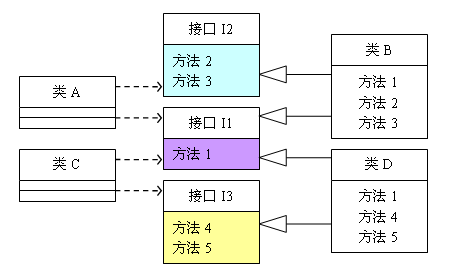转自https://www.cnblogs.com/shijingjing07/p/6227728.html
1.设计模式的目的
设计模式是为了更好的代码重用性,可读性,可靠性,可维护性。
2.常用的六大设计模式
1)单一职责原则
2)里氏替换原则
3)依赖倒转原则
4)接口隔离原则
5)迪米特法则
6)开闭原则
3.单一职责原则
该原则是针对类来说的,即一个类应该只负责一项职责。
如类T负责两个不同职责:职责P1,职责P2。当职责P1需求变更而改变T时,可能造成职责P2发生故障,所以需要将类T的粒度分解为T1,T2。
示例如下:
用一个类秒数动物呼吸这个场景
class Animal {
public void breathe(string animal)
{
Console.WriteLine(animal+"呼吸空气");
}
}
class Program
{
static void Main(string[] args)
{
Animal animal = new Animal();
animal.breathe("牛");
animal.breathe("羊");
animal.breathe("猪");
animal.breathe("鱼");
Console.ReadLine();
}
}
输出结果:

我们发现不是所有动物都是呼吸空气的,比如鱼就是呼吸水的,根据单一职责原则,我们将Animal类细分为陆生动物类和水生动物类,如下所示:
class Terrestrial
{
public void breathe(string animal)
{
Console.WriteLine(animal+"呼吸空气");
}
}
class Aquatic
{
public void breathe(string animal)
{
Console.WriteLine(animal + "呼吸水");
}
}
class Program
{
static void Main(string[] args)
{
Terrestrial terrestrial = new Terrestrial();
terrestrial.breathe("牛");
terrestrial.breathe("羊");
terrestrial.breathe("猪");
Aquatic aquatic = new Aquatic();
aquatic.breathe("鱼");
Console.ReadLine();
}
}
我们发现这样修改的花销很大,既要将原来的类分解,又要修改客户端。而直接修改Animal类虽然违背了单一职责原则,但花销小的多,如下所示:
class Animal
{
public void breathe(string animal)
{
if ("鱼".Equals(animal))
{
Console.WriteLine(animal + "呼吸水");
}
else {
Console.WriteLine(animal + "呼吸空气");
}
}
}
class Program
{
static void Main(string[] args)
{
Animal animal = new Animal();
animal.breathe("牛");
animal.breathe("羊");
animal.breathe("猪");
animal.breathe("鱼");
Console.ReadLine();
}
}
可以看到,这种修改方式简单的多。但却存在隐患,一天需要将鱼分为淡水鱼,海水鱼,又需要修改Animal类的breathe方法。可能给“猪牛羊”等相关功能带来风险,这种修改直接在代码级别违背了单一职责原则,虽然修改起来最简单,但隐患最大。还有一种修改方式:
class Animal
{
public void breathe(string animal)
{
Console.WriteLine(animal + "呼吸空气");
}
public void breathe2(string animal)
{
Console.WriteLine(animal + "呼吸水");
}
}
class Program
{
static void Main(string[] args)
{
Animal animal = new Animal();
animal.breathe("牛");
animal.breathe("羊");
animal.breathe("猪");
animal.breathe2("鱼");
Console.ReadLine();
}
}
这种修改方式没有改动原来的方法,而是在类中新加了一个方法,这样虽然违背了单一职责原则,但在方法级别上却是符合单一职责原则的。那么在实际编程中,采用哪一种呢?我的原则是,只有逻辑足够简单,才可以在代码级违反单一职责原则;只有类中方法数量足够少,才可以在方法级别违反单一职责原则。
遵循单一职责的优点:
1)降低类的复杂度,一个类只负责一项职责。
2)提高类的可读性,可维护性
3)降低变更引起的风险。
4.里氏替换原则
该原则是在1988年,由麻省理工学院的以为姓里的女士提出的。
如果对每个类型为T1的对象o1,都有类型为T2的对象o2,使得以T1定义的所有程序P在所有的对象o1都代换成o2时,程序P的行为没有发生变化,那么类型T2是类型T1的子类型。
换句话说,所有引用基类的地方必须能透明地使用其子类的对象。
由定义可知,在使用继承时,遵循里氏替换原则,在子类中尽量不要重写和重载父类的方法。
继承包含这样一层含义:父类中凡是已经实现好的方法(相对抽象方法而言),实际上是在设定一系列的规范和契约,虽然它不强制要求所有的子类必须遵循这些契约,但是如果子类对这些非抽象方法任意修改,就会对整个继承体系造成破坏。而里氏替换原则就是表达了这一层含义。
继承作为面向对象三大特性之一,在给程序设计带来巨大遍历的同时,也带来了弊端。比如使用继承会给程序带来侵入性,程序的可移植性降低,增加对象间的耦合性,如果一个类被其他的类所继承,则当这个类需要修改时,必须考虑到所有的子类,并且父类修改后,所有涉及到子类的功能都有可能产生故障。
举例说明继承的风险,我们需要完成一个两数相减的功能,由类A来负责。
class A{
public int func1(int a,int b){
return a-b;
}
}
public class Client{
public static void main(string[] args){
A a=new A();
System.out.println("100-50="+a.func1(100,50));
System.out.println("100-80="+a.func1(100,80));
}
}
运行结果:
100-50=50
100-80=20
后来,我们需要增加一个新的功能:完成两数相加,然后再与100求和,由类B来负责。
Class B extends A{
public int func1(int a,int b){
return a+b;
}
public int func2(int a,int b){
return func1(a,b)+100;
}
}
public class Client{
public static void main(string[] args){
B a=new B();
System.out.println("100-50="+b.func1(100,50));
System.out.println("100-80="+b.func1(100,80));
System.out.println("100+20+100="+b.func2(100,20));
}
}
运行结果:
100-50=150
100-80=180
100+20+100=220
我们发现原来运行正常的相减功能发生了错误。原因就是类B无意中重写了父类的方法,造成原有功能出现错误。在实际编程中,我们常常会通过重写父类的方法完成新的功能,这样写起来虽然简单,但整个继承体系的复用性会比较差。特别是运行多态比较频繁的时候,如果非要重写父类的方法,通用的做法是:原来的父类和子类都继承一个更通俗的基类,原有的继承关系去掉,采用依赖,聚合,组合等关系代替。
5.依赖倒转原则
高层模块不应该依赖低层模块,二者都应该依赖其抽象;抽象不应该依赖细节,细节应该依赖抽象。
类A直接依赖类B,如果要将类A改为依赖类C,则必须通过修改类A的代码来达成。此时,类A一般是高层模块,负责复杂的业务逻辑,类B和类C是低层模块,负责基本的原子操作;修改A会给程序带来风险。
将类A修改未依赖接口I,类B和类C各自实现接口I,类A通过接口I间接与类B或类C发生联系,则会大大降低修改类A的记几率。
依赖倒置原则基于这样一个事实:相对于细节的多变性,抽象的东西要稳定的多。以抽象为基础搭建的架构比以细节为基础的架构要稳定的多。在java中,抽象指的是接口或抽象类,细节就是具体的实现类,使用接口或抽象类的目的是制定好规范,而不涉及任何具体的操作,把展现细节的任务交给他们的实现类去完成。
依赖倒置的中心思想是面向接口编程。
代码示例如下:
class Book {
public string getContent() {
return "很久很久以前。。。。。";
}
}
class Mother {
public void narrate(Book book)
{
Console.WriteLine(book.getContent());
}
}
class Program
{
static void Main(string[] args)
{
Mother monther = new Mother();
monther.narrate(new Book());
Console.ReadLine();
}
}
运行结果:

如果读的对象是报纸,杂志,却发现客户端不适用了。
我们引入一个抽象的接口IReader,代表读物
interface IReader{
public string getContent();
}
这样Mother类与接口IReader发生依赖关系,而Book和Newspaper都属于读物的范畴,他们各自都去实现IReader接口,这样就符合依赖倒置原则了,修改代码如下:
interface IReader {
string getContent();
}
class Newspaper: IReader
{
public string getContent()
{
return "切尔西豪取12连胜";
}
}
class Book:IReader
{
public string getContent()
{
return "很久很久以前。。。。";
}
}
class Mother
{
public void narrate(IReader reader)
{
Console.WriteLine(reader.getContent());
}
}
class Program
{
static void Main(string[] args)
{
Mother monther = new Mother();
monther.narrate(new Book());
monther.narrate(new Newspaper());
Console.ReadLine();
}
}
运行结果:

采用依赖倒置原则给多人并行开发带来极大的便利,比如上列中Mother类与Book类直接耦合,Mother必须等Book类编码完成后才可以进行编码,因为Mother类依赖于Book类。修改后的程序可以同时开工,互不影响。
依赖关系的传递有三种方式,接口传递,构造方法传递和setter方法传递。
接口传递:
interface IDriver{
public void drive(ICar car);
}
public class Driver:IDriver{
public void drive(ICar car){
car.run();
}
}
构造方法传递:
interface IDriver{
public void drive();
}
public class Driver implements IDriver{
public ICar car;
public Driver(ICar _car){
this.car=_car;
}
public void drive(){
this.car.run();
}
}
setter方式传递:
interface IDriver{
public void setCar(ICar car);
public void drive();
}
public class Driver:IDriver{
PRIVATE ICar car;
public void setCar(ICar car){
this.car=car;
}
public void drive(){
this.car.run();
}
}
在实际编程中,一般需要做到如下3点:
低层模块尽量都要有抽象类或接口,或者两者都有。
变量的声明类型尽量是抽象类或接口。
使用继承时遵循里氏替换原则
6.接口隔离原则
客户端不应该依赖它不需要的接口;一个类对另一个类的依赖应该建立在最小的接口上。
类A通过接口I依赖类B,类C通过接口I依赖类D,如果接口I对于类A和类C来说不是最小接口,则类B和类D必须去实现他们不需要的方法。
将臃肿的接口I拆分为独立的几个接口,类A和类C分别与他们需要的接口建立依赖关系。也就是采用接口隔离原则。
举例说明接口隔离原则:

这个图的意思是:类A依赖接口I中的方法1,方法2,方法3,类B是对类A依赖的实现;类C依赖接口I中的方法1,方法4,方法5,类D是对类C依赖的实现。对于类B和类D来说,虽然存在用不到的方法(红色标记所示),但由于实现了接口I,所以也必须要实现这些用不到的方法。代码如下:
interface I{
void method1();
void method2();
void method3();
void method4();
void method5();
}
class A{
public void depend1(I i){
i.method1();
}
public void depend2(I i){
i.method2();
}
public void depend3(I i){
i.method3();
}
}
class C{
public void depend1(I i){
i.method1();
}
public void depend2(I i){
i.method4();
}
public void depend3(I i){
i.method5();
}
}
class B:I{
public void method1(){
Console.WriteLine("类B实现接口I的方法1");
}
public void method2(){
Console.WriteLine("类B实现接口I的方法2");
}
public void method3(){
Console.WriteLine("类B实现接口I的方法3");
}
public void method4(){}
public void method5(){}
}
class D:I{
public void method1(){
Console.WriteLine("类B实现接口I的方法1");
}
public void method2(){}
public void method3(){}
public void method4(){
Console.WriteLine("类B实现接口I的方法4");
}
public void method5(){
Console.WriteLine("类B实现接口I的方法5");
}
}
class Program
{
static void Main(string[] args)
{
A a=new A();
a.depend1(new B());
a.depend2(new B());
a.depend3(new B());
C c=new C();
c.depend1(new D());
c.depend2(new D());
c.depend3(new D());
Console.ReadLine();
}
}
可以看到,接口中出现的方法,不管对依赖于它的类有没有作用,实现类中都必须去实现这些方法。于是我们将原接口I拆分为三个接口:

代码如下所示:
interface I1{
void method1();
}
interface I2{
void method2();
void method3();
}
interface I3{
void method4();
void method5();
}
class A{
public void depend1(I1 i){
i.method1();
}
public void depend2(I2 i){
i.method2();
}
public void depend3(I2 i){
i.method3();
}
}
class C{
public void depend1(I1 i){
i.method1();
}
public void depend2(I3 i){
i.method4();
}
public void depend3(I3 i){
i.method5();
}
}
class B:I1,I2{
public void method1(){
Console.WriteLine("类B实现接口I1的方法1");
}
public void method2(){
Console.WriteLine("类B实现接口I2的方法2");
}
public void method3(){
Console.WriteLine("类B实现接口I2的方法3");
}
}
class D:I1,I3{
public void method1(){
Console.WriteLine("类B实现接口I的方法1");
}
public void method4(){
Console.WriteLine("类B实现接口I的方法4");
}
public void method5(){
Console.WriteLine("类B实现接口I的方法5");
}
}
class Program
{
static void Main(string[] args)
{
A a=new A();
a.depend1(new B());
a.depend2(new B());
a.depend3(new B());
C c=new C();
c.depend1(new D());
c.depend2(new D());
c.depend3(new D());
Console.ReadLine();
}
}
说到这里,可能会觉得接口隔离原则和之前的单一职责原则很相似,其实不然。一,单一职责注重职责,而接口隔离原则注重对接口依赖的隔离;二,单一职责是约束类,其次是方法,针对的是程序中的实现和细节;而接口隔离原则约束的是接口,针对的是抽象,程序整体框架的构建。
7.迪米特法则
一个对象应该对其他对象保持最少的了解。
类与类关系越密切,耦合度越大。
迪米特法则又叫最少知道原则,即一个类对自己依赖的类知道的越少越好。也就是说,对于被依赖的类不管多么复杂,都尽量将逻辑封装在类的内部。对外除了提供的public 方法,不对外泄露任何信息。
迪米特法则还有个更简单的定义:只与直接的朋友通信。
什么是直接的朋友:每个对象都会与其他对象由耦合关系,只要两个对象之间有耦合关系,我们就说这两个对象之间是朋友关系。耦合的方式很多,依赖,关联,组合,聚合等。其中,我们称出现成员变量,方法参数,方法返回值中的类为直接的朋友,而出现在局部变量中的类不是直接的朋友。也就是说,陌生的类最好不要以局部变量的形式出现在类的内部。
举例额说明如下,有一个集团公司,下属单位有分公司和直属部门,现要求打印出所有下属单位的员工ID。
class Employee{
private string id;
public void setId(string id){
this.id=id;
}
public string getId(){
return id;
}
}
class SubEmployee{
private string id;
public void setId(string id){
this.id=id;
}
public string getId(){
return id;
}
}
class SubCompanyManager{
public List<SubEmployee> getAllEmployee(){
List<SubEmployee> list=new ArrayList(SubEmployee);
for(int i=0;i<100;i++){
SubEmployee emp=new SubEmployee();
emp.setId("分公司"+i);
list.add(emp);
}
return list;
}
}
class CompanyManager{
public List<Employee> getAllEmployee(){
List<Employee> list=new ArrayList<Employee>();
for(int i=0;i<30;i++)
{
Employee emp=new Employee();
emp.setId("总公司"+i);
list.add(emp);
}
return list;
}
publi void printAllEmployee(SubCompanyManager sub){
List<SubEmployee> list1=sub.getAllEmployee();
foreach(SubEmployee e in list1){
Console.WriteLine(e.getId());
}
List<Employee> list2=this.getAllEmployee();
foreach(Employee e in list2){
Console.WriteLine(e.getId());
}
}
}
class Program
{
static void Main(string[] args)
{
CompanyManager e=new CompanyManager();
e.printAllEmployee(new SubCompanyManager());
Console.ReadLine();
}
}
这个设计的问题在于CompanyManager中,SubEmployee类并不是CompanyManager类的直接朋友,按照迪米特法则,应该避免类中出现这样非直接朋友关系的耦合。修改后的代码如下:
class SubCompanyManager{
public List<SubEmployee> getAllEmployee(){
List<SubEmployee> list = new ArrayList<SubEmployee>();
for(int i=0; i<100; i++){
SubEmployee emp = new SubEmployee();
//为分公司人员按顺序分配一个ID
emp.setId("分公司"+i);
list.add(emp);
}
return list;
}
public void printEmployee(){
List<SubEmployee> list = this.getAllEmployee();
for(SubEmployee e:list){
System.out.println(e.getId());
}
}
}
class CompanyManager{
public List<Employee> getAllEmployee(){
List<Employee> list = new ArrayList<Employee>();
for(int i=0; i<30; i++){
Employee emp = new Employee();
//为总公司人员按顺序分配一个ID
emp.setId("总公司"+i);
list.add(emp);
}
return list;
}
public void printAllEmployee(SubCompanyManager sub){
sub.printEmployee();
List<Employee> list2 = this.getAllEmployee();
for(Employee e:list2){
System.out.println(e.getId());
}
}
}
迪米特法则的初衷是降低类之间的耦合,由于每个类都减少了不必要的依赖,因此的确可以降低耦合关系。
8.开闭原则
一个软件实体如类,模块和函数应该对扩展开放,对修改关闭。用抽象构建框架,用实现扩展细节。
当软件需要变化时,尽量通过扩展软件实体的行为来实现变化,而不是通过修改已有的代码来实现变化。
当我们遵循前面介绍的5大原则,以及使用23中设计模式的目的就是遵循开闭原则。
